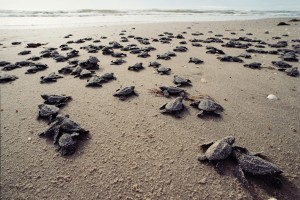Importance of sea turtles
Sea turtles have been swimming through the ocean for more than 100 million years, and during this time have become fundamental elements of many marine ecosystems. Sea turtles increase the productivity of seagrass beds. Seagrass beds are some of the most productive ecosystems in the world, but their level of productivity is dependent on continued grazing. Green sea turtles Chelonia agassizii are one of the very few species that feeds on seagrass, and are thus essential to its health. Leatherback turtles Dermochelys coriacea have an important ecological role of limiting jellyfish populations which, because they reproduce so quickly, could exponentially increase and dominate many marine ecosystems. Though most of their lifetime is spent in the ocean, female sea turtles must come ashore to lay their eggs. Unfortunately for the turtles many hatchlings don’t make it safely back to sea; however, these eggs and hatchlings are a source of high-quality nutrients to predators and add nutrients to an already nutrient-limited beach ecosystem.
must come ashore to lay their eggs. Unfortunately for the turtles many hatchlings don’t make it safely back to sea; however, these eggs and hatchlings are a source of high-quality nutrients to predators and add nutrients to an already nutrient-limited beach ecosystem.
Current threats to sea turtles
During the time of Columbus’ voyages to the Caribbean, populations were estimated to be 33-660 million turtles, but now all seven species of sea turtles are threatened with extinction. The IUCN Red List classifies loggerhead turtles as endangered and leatherback turtles as critically endangered. It has been estimated that between 1984 and 2004, Pacific loggerhead and leatherback turtle populations declined by 80-95%. A major cause of their decline has been fisheries by-catch (i.e. the incidental capture of non-target species). It was estimated that 200,000 loggerheads and 50,000 leatherbacks were caught accidentally in pelagic longline fisheries in the year 2000. Sea turtles live for an extremely long time (over 100 years) and have delayed maturity, making them very susceptible to poor fishing practices. Many of these fisheries were using traditional J hooks to catch target fish, and upon taking the bait, sea turtles (and other species) often swallowed these (relatively) small hooks. When fishers tried to remove the hooks, injuries were exacerbated and turtles often died after being released.
References:
IUCN Red List of Endangered Species http://www.iucnredlist.org/
Lewison, R.L., Freeman, S.A., Crowder, L.B., 2004. Quantifying the effect of fisheries on threatened species: the impact of pelagic longlines on loggerhead and leatherback sea turtles. Ecology Letters, 7, 221–231.
Nash, N. (2012, March 30) More on leatherback turtles from our own teammate Nicola Nash [Web log content] Retrieved from http://www.adventureantigua.com/2012/03/30/more-on-leatherback-turtles-from-our-own-teammate-nicola-nash/
Read, A. (2007) Do circle hooks reduce the mortality of sea turtles in pelagic longlines? A review of recent experiments. Biological Conservation, 135, 155-169.
Wilson, E.G., Miller, K.L., Allison, D., & Magliocca, M. (2010) Why Healthy Oceans Need Sea Turtles: The Importance of Sea Turtles to Marine Ecosystems. Oceana report. Obtained from http://oceana.org/es/news-media/publications/reports/why-healthy-oceans-need-sea-turtles-the-importance-of-sea-turtles-to-marine-ecosystems
Photo obtained from http://blog.mexi-go.ca/sea-turtles-can-feel-safe-in-mexico-thanks-to-new-protections/
